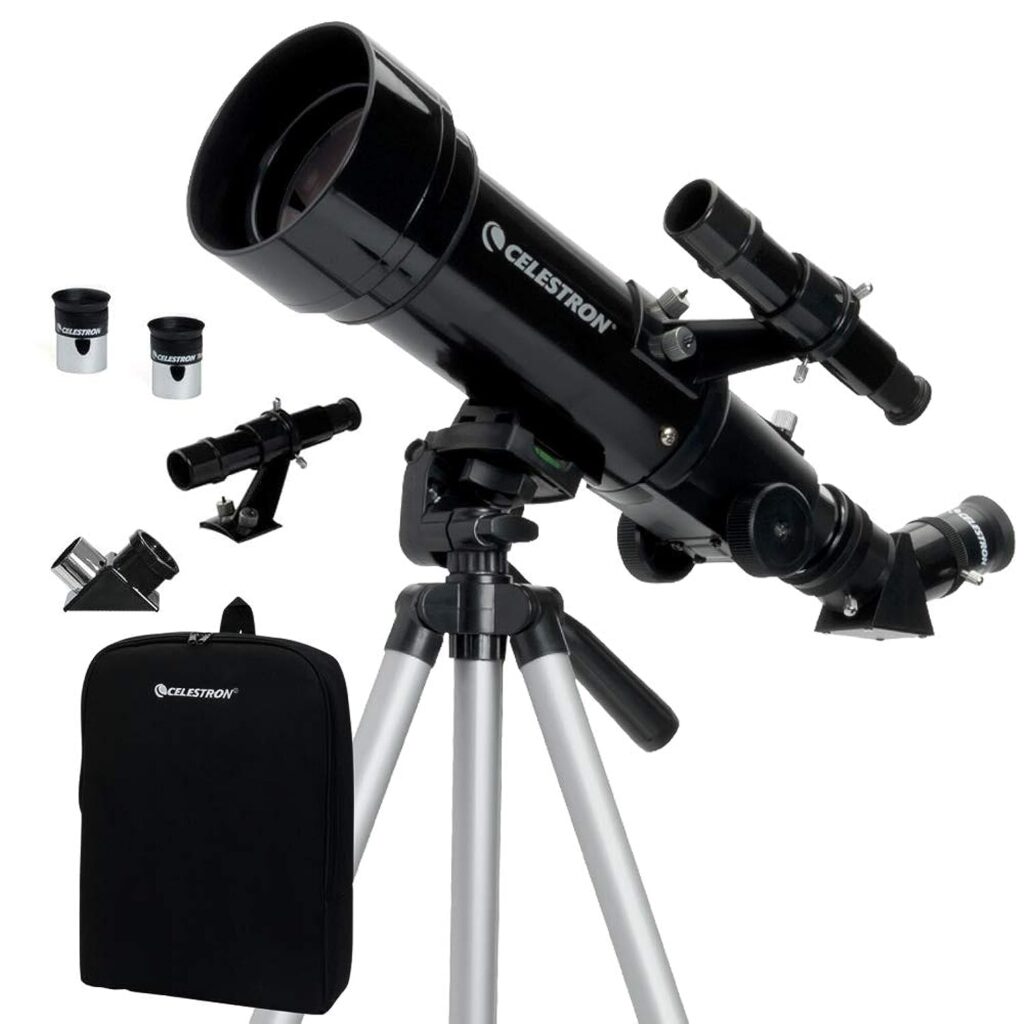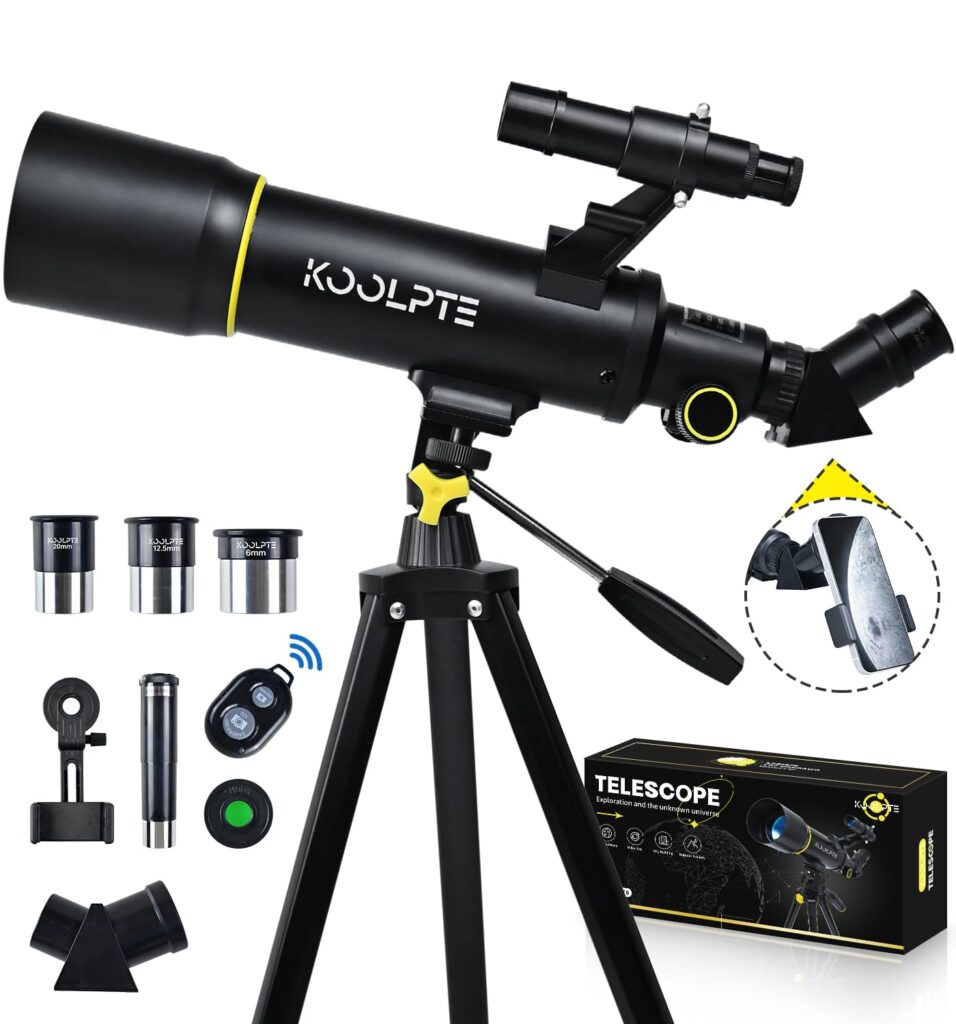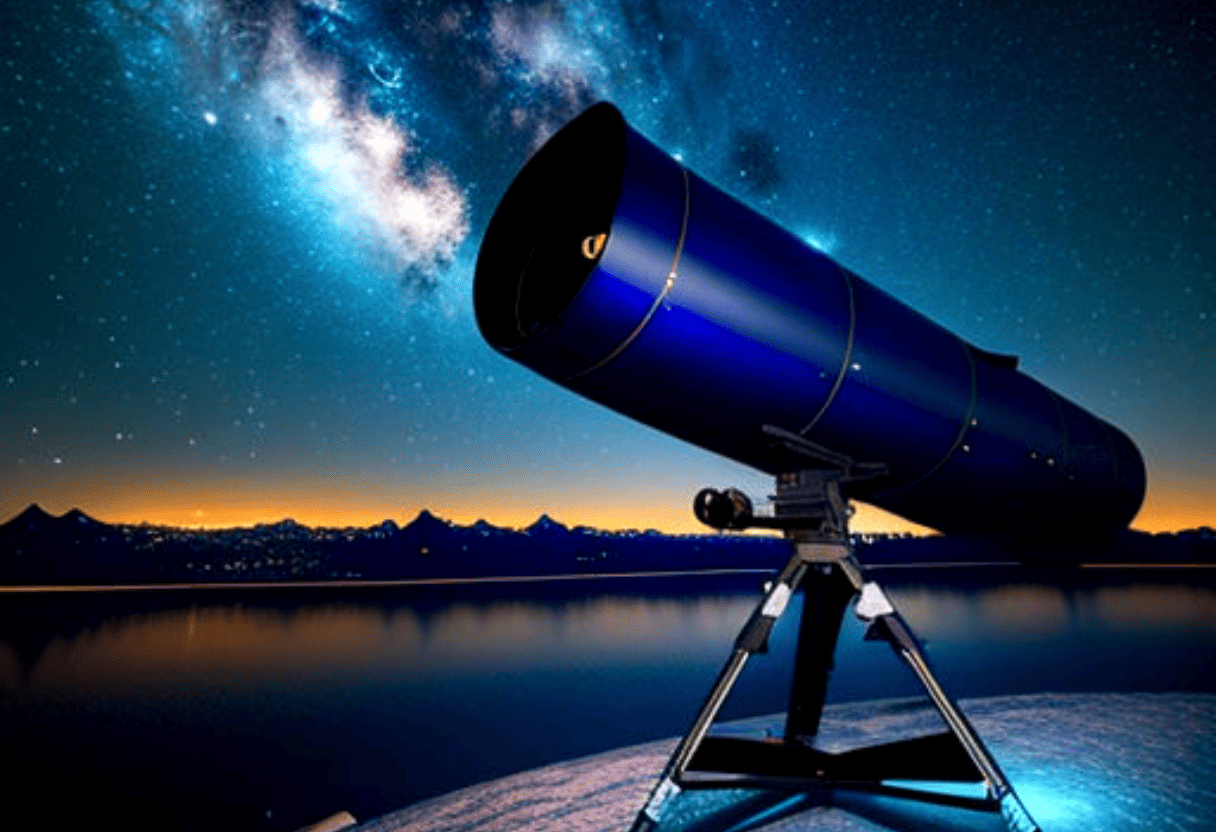Are you starstruck by the cosmos and searching for the best telescope on Amazon for a stellar viewing experience in 2024?
The right telescope can be your gateway to the universe, offering vivid images of distant galaxies, nebulae, and planets. On Amazon, the variety of telescopes available caters to all—from amateur stargazers to seasoned astronomers.
Well, we’ll be going over:
- How does aperture size influence your choice of a telescope for different astronomical pursuits?
- Why is the type and quality of the telescope mount so crucial for effective sky observations?
- What should beginners consider when selecting a telescope to ensure a balance between user-friendliness and advanced features?
Discovering the perfect telescope is about aligning your celestial curiosities with the right equipment.
Let’s dive in.
Top-Rated Telescopes on Amazon
- Celestron 80mm Travel Telescope – Top Pick
- Celestron Travel Scope 70
- Koolpte Discovery Scope
- Gskyer AZ80400 Telescope
- StarSense Explorer
I’ve explored the vast array of telescopes available on Amazon to bring you a curated selection of the finest models. Whether you’re an astronomy enthusiast or a curious stargazer, my picks cater to a variety of needs and skill levels. From user-friendly telescopes for beginners to sophisticated gear for experienced observers, each product stands out for its quality, user reviews, and features that offer value for your investment in cosmic exploration.
Celestron 80mm Travel Telescope

Having recently tried out the Celestron 80mm Travel Telescope, I find it’s an excellent option for newcomers to astronomy and those looking for a portable stargazing companion.
Pros
Cons
The Celestron 80mm Travel Telescope is a dream for anyone starting their journey into astronomy. It’s lightweight and slips comfortably into the provided backpack, meaning I can take it anywhere without hassle. The optics don’t disappoint either; the crisp and bright views they provide make stargazing a delightful experience. Night after night, this telescope has proven its worth, allowing me to gaze at the Moon’s craggy surface and even pick out the rings of Saturn on a clear evening.
What I appreciate about this telescope is how it respects my time. I don’t fiddle with tools or thumb through complicated manuals. I just set it up in mere moments and immediately start exploring the skies. The included eyepieces offer varied levels of magnification, which is great for either close-up or wide-field observations. However, it’s worth mentioning that if you’re aiming for high-powered observations, you might want to consider upgrading the tripod for better stability.
Admittedly, there are some kinks when it comes to using the smartphone adapter. It’s a bit of a hit or miss, depending on your phone model and case, but when it does fit, it’s a blast capturing images of celestial objects. The software that comes with the telescope is a fantastic bonus, offering heaps of informative material to both entertain and educate.
In essence, the Celestron 80mm Travel Telescope is a robust starting point for any aspiring astronomer. Its shortcomings are far outweighed by the quality and functionality it offers at this price point. If you’re in search of a telescope that combines portability with performance, this might just be the one for you.
Celestron Travel Scope 70

I would wholeheartedly recommend this telescope for its ease of use and portability, making it a superb choice for beginners and travelers alike.
Pros
Cons
After a weekend of stargazing with the Celestron Travel Scope 70, I was genuinely impressed by the crisp clarity of the stars and planets. Its ease of setup meant I could quickly get to observing the night sky, a real treat for someone who values their time under the stars. The lightweight design did not go unnoticed, as I could move it around without any hassle, and repacking it into its dedicated backpack was just as convenient.
Using both eyepieces, I witnessed the marked difference in magnification, enjoying both wide field views and more zoomed perspectives of the moon’s craters. Throughout my observation sessions, the fully-coated optics delivered bright and pleasurable views. However, when focusing on distant celestial objects, I noticed that the tripod’s slight wobble became evident, and it took a gentle touch to keep the view steady.
The bonus of having Celestron’s astronomy software complemented my stargazing experience. It was an educational accompaniment that aided in identifying stars and constellations, enriching the learning process. This telescope, while perfect for novice astronomers and children eager to explore the cosmos, might not satisfy the appetite of seasoned stargazers due to its limited advanced capabilities. That said, for its price and with its user-friendly approach, it presents a worthy investment for those breaking into the world of astronomy.
Koolpte Discovery Scope

After spending an evening under the stars with the Koolpte Discovery Scope, I can confidently say it’s a great choice for anyone starting their stargazing adventures.
Pros
Cons
When I first got my hands on the Koolpte Discovery Scope, assembly took some attention, but it was worth it. The telescope feels robust and the provided instructions guide you through setup. Once it’s assembled, the real fun begins. The device is pretty straightforward, and within minutes, I found myself immersed in the night sky’s wonders.
The visual clarity is what struck me most; celestial bodies appear vibrant and detailed. I also appreciated the adjustable tripod and the phone adapter, which allowed me to quickly capture photos to share with friends. Swapping out eyepieces to tinker with magnification became a breeze once I familiarized myself with the process.
However, I would suggest finding a shielded spot if it’s a breezy night, as the tripod, while portable, can wobble a bit. Also, achieving the perfect focus might require a gentle touch and some practice. Once you get the hang of it, though, observing the moon’s craters or spotting Jupiter’s moons becomes incredibly rewarding.
Overall, the Koolpte Discovery Scope has been a delightful addition to my outdoor adventures. It’s lightweight enough to take on the go, yet powerful enough to bring the stars closer. Whether you’re simply moon-gazing or dipping your toes into deeper astronomical waters, this telescope serves as a solid bridge between accessibility and functionality.
Gskyer AZ80400 Telescope

I would recommend this Gskyer telescope for anyone starting their journey into astronomy due to its user-friendly setup and quality optics.
Pros
Cons
Having spent some nights gazing at the stars, I found setting up the Gskyer AZ80400 Telescope straightforward. This telescope, fit for amateurs and enthusiasts alike, made it easy to get a crystal-clear view of the moon and planets. The optics are impressive for a telescope in this price bracket, providing bright and sharp images that truly enhance the stargazing experience.
In my use, the adjustable tripod was a boon, allowing me to find the perfect angle for watching celestial movements without any hassle. This level of adjustability is something I value highly in my astronomical pursuits, especially during long observation sessions where comfort is key.
However, I did notice that while the telescope is generally stable, it can be sensitive to windier conditions. Moreover, the manual could be more user-friendly. It assumes some level of prior knowledge, which might be challenging for beginners to understand immediately. Regardless, once I got the hang of it, using the Gskyer AZ80400 was a delight.
The interchangeable eyepieces add to the versatility of the telescope, offering multiple magnification options that are easy to switch out. This feature brings planets like Saturn, Jupiter, and their moons into closer view, making for some memorable viewing moments.
Overall, despite some minor drawbacks, my experience with the Gskyer AZ80400 was very positive. It’s a solid choice for anyone looking to start exploring the night sky with a reliable and capable instrument.
StarSense Explorer

If you’re eager to explore the cosmos with minimal fuss and excellent guidance, the StarSense Explorer is sure to impress.
Pros
Cons
Having spent some quality time scanning the heavens with the StarSense Explorer, I was quite taken with its user-friendly technology. The patented sky recognition technology truly does the heavy lifting, allowing users like myself to pinpoint celestial wonders with ease. I was especially grateful for the on-screen arrows in the app; they serve as a convenient guide, leading me right to the celestial objects I sought.
The views delivered by the 80mm refractor are sharp and clear – Saturn’s rings came to life in a way that photos could never replicate. The brilliance of star clusters and the delicate details on the Moon’s surface were simply spellbinding. The quality of the optics is undeniable, a hallmark of the Celestron brand, which has been reliably outfitting amateur astronomers for decades.
Admittedly, getting the smartphone alignment just right took some doing, and a few attempts were needed to streamline the process. However, navigating these initial hurdles was well worth it for the payoff. The manual focus and altazimuth mount require a subtle touch to follow objects as the Earth rotates, but it’s all part of the hands-on experience that deepens one’s appreciation for the night sky.
In the grand scheme of things, the few inconveniences are minor when weighed against the awe-inspiring moments this telescope provides. It’s a solid choice for beginners and seasoned sky gazers who value a blend of convenience and quality in their stargazing adventures.
Buying Guide
Understanding Magnification and Aperture
When I’m choosing a telescope, I always prioritize the aperture—the diameter of the main optical component (lens or mirror). A larger aperture gathers more light, which is essential for viewing faint objects. Magnification, while important, is secondary because it can be adjusted with different eyepieces. However, a rule of thumb is that the maximum useful magnification is 50 times the aperture in inches.
Types of Telescopes
There are three main types:
- Refractors – Use lenses.
- Reflectors – Use mirrors.
- Catadioptric – Combination of lenses and mirrors.
Each type has its pros and cons, with refractors being better for planetary observations and reflectors for deep-sky viewing.
Mounts
The stability and type of mount are crucial for a good stargazing experience. There are two main types:
- Altazimuth – Simpler, up-down and left-right motion.
- Equatorial – Compensates for Earth’s rotation, better for long-term tracking.
Additional Features
Here’s what else to consider:
| Feature | Why it Matters |
|---|---|
| Eyepieces | Variety of magnifications |
| Finderscope | Aids in locating objects |
| GoTo Technology | Automated object location |
My advice is to focus on a high-quality optical system, as I can always upgrade accessories later on. It’s important to strike a balance between portability and performance, keeping in mind where and how I’ll be using my telescope.
Frequently Asked Questions
In this section, I will address some of the most common inquiries I’ve received regarding telescopes on Amazon. This should guide you in making an informed purchase, whether you’re a new stargazer or looking to refine your astronomical observations.
What are the best telescopes for beginners currently available on Amazon?
On Amazon, the Celestron AstroMaster 70AZ Telescope stands out as an excellent choice for beginners due to its ease of use, clear instructions, and affordability. Equipped with a 70mm aperture and a sturdy altazimuth mount, it strikes a balance between performance and user-friendliness.
How to determine the best value for money when purchasing a telescope on Amazon?
To get the best value for money, compare telescopes within your budget based on customer reviews, warranty, and included accessories. A good value is the Orion StarBlast II 4.5 Equatorial Reflector Telescope, which provides a combination of quality optics and the essential features needed for a satisfying stargazing experience without breaking the bank.
What features should I look for in a telescope if my main interest is astronomy?
For astronomy enthusiasts, a telescope with a large aperture is crucial for capturing more light and seeing faint celestial objects clearly. Also look for a model with a sturdy mount and fine adjustment capabilities, such as the Sky-Watcher 8” Traditional Dobsonian, which excels in deep-sky observations.
Which telescopes are recommended for detailed planet viewing?
The Celestron NexStar 5SE Telescope is a favorite for planet viewing. Its 5-inch aperture and sophisticated computerized tracking system allow for sharp, detailed views of planets. Its portability and user-friendly design make it an ideal choice for both beginners and seasoned observers.
What are the top-rated telescopes for adults who are beginners?
Adult beginners often prefer telescopes that combine simplicity with the ability to grow into the hobby. The Gskyer Telescope, 600x90mm AZ Astronomical Refractor Telescope, receives high marks for its clear optics, German technology equatorial mount, and accessory kit, providing an approachable yet expandable astronomy experience.
What specifications are important in a telescope for viewing both planets and galaxies?
To enjoy views of both planets and galaxies, you should look for a telescope with a large aperture, a high-quality eyepiece, at least a 25mm and 10mm for versatility, and a sturdy mount for stability. The aperture is especially important—opt for a minimum of 8 inches, like with the Orion SkyQuest XT8 Classic Dobsonian, to ensure clear viewing of a wide range of celestial objects.







